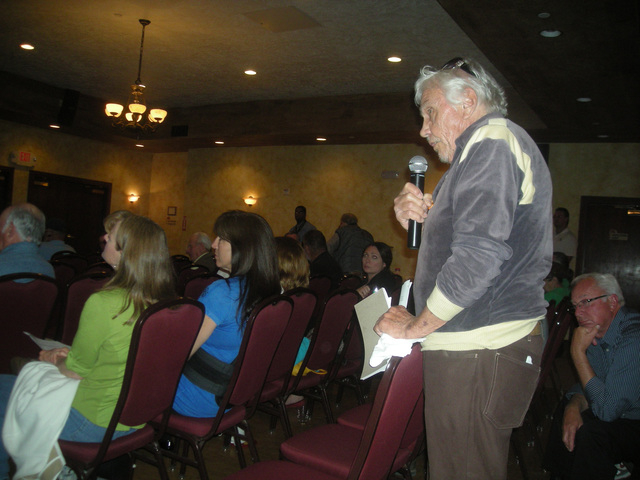
Two Valley Electric Association board members were easily re-elected to three-year terms in district meetings last week.
District 6 board member Dave Dawson, a retiree who worked 35 years in strategic planning and manufacturing operations for aerospace company United Technologies, who represents the area north of Highway 372 in Pahrump, won 433 votes after the meeting at Nevada Treasure RV Resort Thursday night. Pro Shed owner Bill Renshaw had 171 votes and Preferred RV Resort activities director Mary Taylor-Marsh had 159, with 763 total votes cast.
District 5 board member Dave Lowe, a former editor for the Las Vegas Review-Journal, personnel director at the Nevada Test Site and Southern Nevada Memorial Hospital, won re-election to the district representing Sandy Valley, Mountain Springs and Trout Canyon, with 67 votes. Trails End General Store owner Ken Derschan had 52 votes, retired electrician Lyal Darrel had six in voting at the Sandy Valley Community Center.
“What I brought to the board I hope was an ability to look at where we were, where we need to be and where we’re going in the future and I hope I brought out-of-the-box thinking in how we’re going to get there,” Dawson, a VEA director since 2008, said.
In his campaign speech, Dawson said when he came to Pahrump in 2007 he didn’t know anything about co-ops, but attended courses to become a certified cooperative director by the National Rural Electric Association in one year.
“Should you give me that opportunity to continue to represent you, I have in the past and I will continue in the future to represent the whole system. Though you elected me to District 6 we directors are not a silo effect,” he said. “We’ve made some very good, intelligent decisions, some of them were very hard, very gut-wrenching and my hat’s off to not only the executive staff but the employees of Valley Electric we turn to when the job needed to be done so we can have the opportunity to not raise rates until 2018.”
Dawson said the VEA ambassadors played a great role in reviewing the campus expansion plans. VEA Chief Executive Officer Tom Husted told members at district meetings they’re running out of room, in posing his own question about the $10 million proposed expansion he said it will also offer a community meeting center available to the public.
Husted posed another question he’s asked about the statewide advertising campaign which he said is their active branding program done to educate business and political leaders.
“Several years ago I had a private meeting with a state senator who now happens to be a U.S. congressman and we were talking about Valley Electric and he said, ‘you mean you’re an electric utility like NV Energy?’ He didn’t know and it’s not his fault. It’s our fault because we did not take the time to educate a business leader and a political leader within this state. These people are making decisions that can have a huge impact on us,” Husted said. “We believe we have something to offer. We spent millions of dollars on our infrastructure, we got a great system.”
An audience member was concerned joining the California Independent System of Operators (CAISO), an organization that runs 80 percent of the California grid, could make VEA subject to rolling brownouts due to short supply.
“We have changed from the NV Energy balancing area over to the California balancing authority area so physically nothing has changed. If California had problems in the past with brownouts that didn’t affect us and we don’t see that affecting us in the future,” Husted said.
He said joining CAISO added $6 million in revenues, the organization is paying for excess capacity VEA has that could be added to their system in the future.
Katrine Romanoff asked whether members would receive a check this December from patronage capital, mailed out when VEA turns a profit, which cooperatives call margins.
“We make that decision at the end of the year and we analyze how the year was, how we actually performed with our budgets and then we make that decision. But over the next five years we’re in a position to do substantial returns in patronage capital,” Husted said.
The cooperative operated at a planned loss in 2012 of more than $7 million, which turned into a positive net margin of $137,477 in 2013, according to VEA Executive Chief Operating Officer Rick Eckert. Husted said the co-op had $20 million in new revenues during 2013 with new federal contracts, along with $7 million in reduced power costs.
The question came up at both Pahrump district meetings about renewable energy projects in the area.
“We have had as high as three gigawatts of proposed solar in our area, a lot of that has come and gone. It’s about two times the output of Hoover Dam and now we have several hundred megawatts that is proposed for our service area. Will that help us? Absolutely,” Husted said. He noted it will create infrastructure, jobs, revenue and pad the utility’s renewable energy portfolio.
Husted said they’re in discussions with a company that will generate solar power in 2016, referring to the proposed First Solar 65 megawatt solar plant in Amargosa Valley.
Florian Schweller complained raising the facility charge from $5 per month to $15 per month after the closure of the cooperative’s biggest customer, the Barrick Bullfrog Mine, in 1999, unfairly impacted people who don’t use much power.
“If we would take that, lower that, but raise the kilowatt hour charge — because you’ve got to get the revenues — that it actually charged the lower end ratepayers more because you’re not making it go away, you’re putting it into another area,” Husted said.